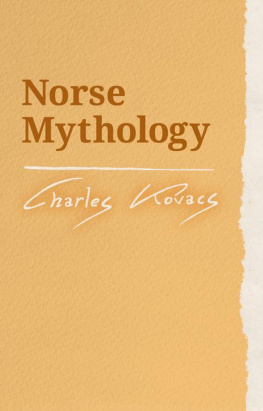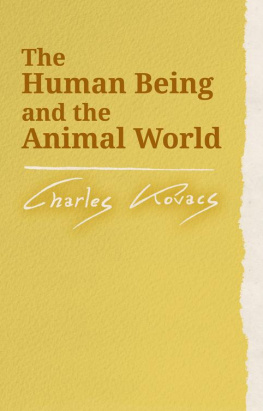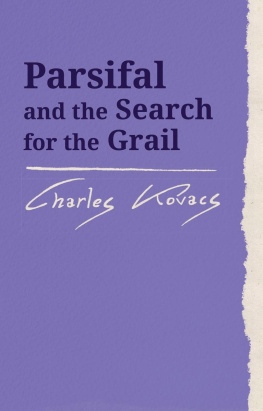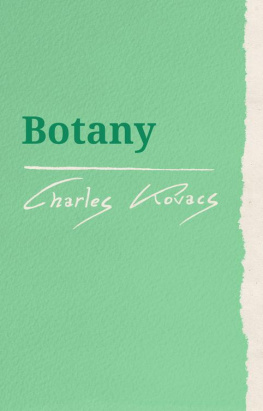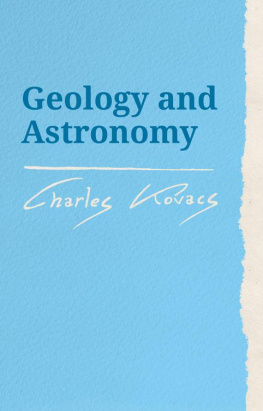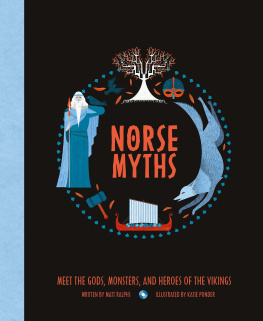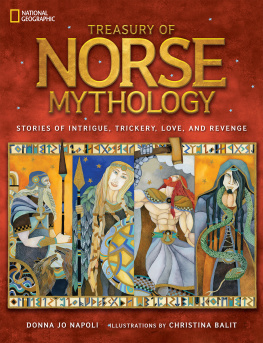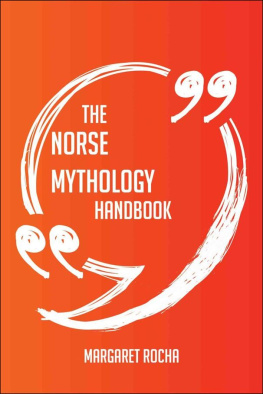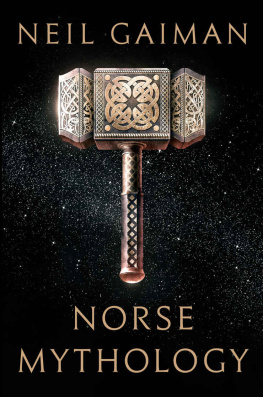Charles Kovacs - Norse Mythology
Here you can read online Charles Kovacs - Norse Mythology full text of the book (entire story) in english for free. Download pdf and epub, get meaning, cover and reviews about this ebook. year: 2020, publisher: Floris Books, genre: Religion. Description of the work, (preface) as well as reviews are available. Best literature library LitArk.com created for fans of good reading and offers a wide selection of genres:
Romance novel
Science fiction
Adventure
Detective
Science
History
Home and family
Prose
Art
Politics
Computer
Non-fiction
Religion
Business
Children
Humor
Choose a favorite category and find really read worthwhile books. Enjoy immersion in the world of imagination, feel the emotions of the characters or learn something new for yourself, make an fascinating discovery.
- Book:Norse Mythology
- Author:
- Publisher:Floris Books
- Genre:
- Year:2020
- Rating:4 / 5
- Favourites:Add to favourites
- Your mark:
- 80
- 1
- 2
- 3
- 4
- 5
Norse Mythology: summary, description and annotation
We offer to read an annotation, description, summary or preface (depends on what the author of the book "Norse Mythology" wrote himself). If you haven't found the necessary information about the book — write in the comments, we will try to find it.
A retelling of the stories of Norse mythology as recommended for the Steiner-Waldorf curriculum Class 4 (age 9-10). Includes myths on Creation, Odin and Mimir, Thor and Thialfi, Idun, Sif and Loki.
Norse Mythology — read online for free the complete book (whole text) full work
Below is the text of the book, divided by pages. System saving the place of the last page read, allows you to conveniently read the book "Norse Mythology" online for free, without having to search again every time where you left off. Put a bookmark, and you can go to the page where you finished reading at any time.
Font size:
Interval:
Bookmark:

The stories I am going to tell are very special. They are wonderful stories of strange beings called gods and of giants and dwarfs, stories of magic spells and of mighty battles. Before I can tell you these stories I must first tell you how they came about. These stories were not just made up; they came about in a different way. So that you can understand how this was, lets think back to the Old Testament stories and the story of Adam and Eve how they ate the forbidden fruit of the Tree of Knowledge of Good and Evil, and how they were driven from paradise. As long as Adam and Eve were still in paradise they could see God and speak to God every day. Just think what a wonderful thing this was: to see the Lord God in all his might and glory, just as you now see people. Then Adam and Eve disobeyed God and were driven from paradise and they could no longer see God every day, but they could still see him sometimes; he sometimes appeared to them.
Then came the children of Adam and Eve, and their childrens children; they could still see God, but not very often. As time went on, there were only a few people who could see God at all: people like Abraham, like Moses, like some prophets and they could only see him sometimes. The more people became used to living on earth, and the better they became at building and farming and making things, the less they could see God. Only a few could still sometimes see him.
Something else happened: people could not see the Lord God in his might and glory, but very many of them, not just a few, could see the angels. They saw angels that made the seasons of the year, the cold of winter and the warmth of the summer. They saw angels that worked in wind and weather, in rain and clouds, in the growing of plants and even in the light that came from the sun and moon and stars. In our time we do not even have that ability; but in the old days, a long time ago, people did not just feel the wind, they saw a wonderful being that made the wind. They did not just see the light of sun or moon; in the light there were beings, the angels.
What happened was this: the people who could no longer see God thought that each angel was a god, and so they came to worship the angels as gods, and they prayed to the angels as gods and made sacrifices to them. The only people who did not worship the angel-gods but remained faithful to the true God were the Israelites, the people of the Old Testament, and that is why Christ was born among them. The other people in the world worshipped the many angel-gods because thats what they could still see. But the true God, in his love for mankind, wanted to help the people who could no longer see him, and so he let his angels guide them.
There were many peoples in the world who worshipped the angel-gods, and they had wonderful stories about them. The most wonderful stories were told amongst people who are called Norsemen, which means men from the North. These Norsemen really did come from the North from Sweden, from Norway. They were a proud people and so brave that they were only happy when there was danger. That is why they went to war and fought: to have the joy of danger. That is why they sailed their small sailing ships across the seas and into the wildest storms: because it was dangerous. The Norsemen came to every land: to Germany, to France, to Britain. Many settled in these countries, so there is hardly anyone here who does not have, among his ancestors his great-great-great-grandparents from very long ago one of these brave warriors, one of the Norsemen. They were all warriors. They carried spears and swords and shields and they knew how to use their weapons well.
When these brave, fierce Norsemen had fought a battle, they came home to celebrate their victory with a great feast a banquet. The most important part of the feast was when a man called a bard took a harp and sang or recited a poem, a long poem about the gods and the deeds of the gods. These bards could see the angel-gods better than the others, and they could understand what the angels said better than the others. This is how the stories I am going to tell you came about. They are stories that these wise bards amongst the Norsemen heard from angels, from the angel-gods.
There is a special name for a story about gods: it is not just called a story, it is called a myth. What you are going to hear are the Myths of the Norsemen. I cannot tell the stories in the way those bards, the wise men, told them. They made their stories into poems, and a very peculiar kind of poem they were. When we learn poems they often rhyme:
Little gnome
Has his home
In the mound
Underground.
The poems of the Norsemen were quite different. The most important thing was that as many words as possible began with the same letter:
Now listen and learn and lose not a letter
Of the story of strife and of storms and strange deeds.
The first story I am going to tell you is a very strange one. It is a myth about the beginning of the world. It is quite different from the Bibles story of creation, but that does not matter. The beginning of the world is something so complicated that the Bible story is one part of it, and the Norsemens story is another. The Norsemens story is this.
In the beginning there was just a vast gap, a yawning abyss, an enormous hole with nothing in it, dark and empty. But there was something to the north of that gap. North is the direction from which our cold weather comes, and north of that vast abyss there was a world of ice mountains, shrouded in dense fog. This world of ice and mist was called Nifelheim, which means home of fog.
There was also something south of the abyss, something that was the very opposite of ice: a world of raging, roaring fire, a world of flame and heat. That world of fire was called Muspelheim, the home of fire.
So we have three things at the beginning of the world: the vast abyss, north of it the world of ice and fog called Nifelheim, and south of it the world of raging fire and flame called Muspelheim.
From the icy mountains of Nifelheim there flowed a great river, which rolled great blocks of ice into the great gap. And it so happened that sparks of the fire in Muspelheim flew down into the abyss and fell on the ice. Because of these fiery sparks the ice began to get soft, and it began to melt. Now comes the very strange part of the story. The ice, as it became soft and rounded, took shape. In fact it became two shapes. It became two beings that were made of ice, but were alive. One was a giant, the biggest giant that ever was, and the other was a giant cow. The giant was called Ymir and the big cow was called Audhumbla. The giant Ymir fed himself with the milk from the udder of the cow, Audhumbla. The cow fed herself by licking the salty crust of the ice.
So those were the first beings in the world. Sometimes the giant Ymir fell asleep and when he slept he was so warm that he sweated, and every drop of sweat became another giant not quite as big as Ymir, but a giant nevertheless. If nothing else had happened, the world would have been nothing but giants uncouth, wild creatures, big and stupid. But something else did happen. Whilst the giant Ymir was asleep, the cow licked the ice. She licked and she licked. Through her licking the ice was softened and took shape, and from it came three beings. They were not crude and clumsy like the giants. They were well shaped, they were beautiful, they were strong and they were wise. These three had divine powers. They were gods and their names were Odin, Vili and Ve.
When Ymir and the giants that had grown from him saw the beautiful forms of the three gods, they hated them, for now they saw how ugly they were themselves. They stormed against Odin, Vili and Ve to try and destroy them. The three gods fought back, and after a terrible battle they killed Ymir and the other giants took flight. But they remained forever the enemies of the gods and they waited for a time when they would take revenge.
Font size:
Interval:
Bookmark:
Similar books «Norse Mythology»
Look at similar books to Norse Mythology. We have selected literature similar in name and meaning in the hope of providing readers with more options to find new, interesting, not yet read works.
Discussion, reviews of the book Norse Mythology and just readers' own opinions. Leave your comments, write what you think about the work, its meaning or the main characters. Specify what exactly you liked and what you didn't like, and why you think so.

